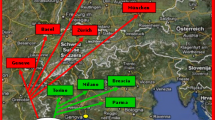Abstract
With rapid expansion of international trade, one distinctive feature of the current port industry is that competition is more intensive than previously. By virtue of information technology enhancement, many efforts to raise port competitiveness through an advanced operation system are actively being made, and judging from the viewpoint of investment effect, these efforts are more preferable than infrastructure expansion and additional equipment acquisition. Based on simulation, this study has tried to prove that RFID-based real-time location system (RTLS) data collection and dynamic operation of transfer equipment brings a positive effect on the productivity improvement and resource utilization enhancement. Moreover, this study on the demand for the real-time data for port operation have been made, and operation processes have been redesigned along with the collection of related data, and based on them, simulations have been conducted. As a result of them, much higher productivity improvement could be expected.
Access this chapter
Tax calculation will be finalised at checkout
Purchases are for personal use only
Similar content being viewed by others
References
Cullinane K, Wang T-F, Song D-W (2006) The technical efficiency of container ports: comparing data envelopment analysis and stochastic frontier analysis. Transp Res Part A 40:354–374
National Committee for Information Technology Standards, TC IT/01-0623
Kim J, Kumara SRT, Yee S-T, Tew J (2005) Dynamic shipment planning in an automobile shipment yard using Real-Time Radio Frequency Identification (RFID) information. In: Proceedings of the 2005 IEEE, Edmonton, Canada, 1–2 Aug 2005, pp 148–153
The report of The Ministry of Maritime Affairs and Fisheries, 2009, pp 69–71
The report of The Ministry of Maritime Affairs and Fisheries, 2010, pp 38–46
The report of The Ministry of Maritime Affairs and Fisheries, 2006, pp 65–72
Seong G-B et al (2010) A study on object-oriented simulation for a container terminal based on DEVS formalism. Korea Port Soc J 14(1):282–298
Author information
Authors and Affiliations
Corresponding author
Editor information
Editors and Affiliations
Rights and permissions
Copyright information
© 2013 Springer-Verlag Berlin Heidelberg
About this paper
Cite this paper
Lu, B., Wang, D. (2013). A Simulation Model for Container Terminal Dynamic Operation System Using Real-Time Positioning Approach. In: Zhang, Z., Zhang, R., Zhang, J. (eds) LISS 2012. Springer, Berlin, Heidelberg. https://doi.org/10.1007/978-3-642-32054-5_129
Download citation
DOI: https://doi.org/10.1007/978-3-642-32054-5_129
Published:
Publisher Name: Springer, Berlin, Heidelberg
Print ISBN: 978-3-642-32053-8
Online ISBN: 978-3-642-32054-5
eBook Packages: Business and EconomicsBusiness and Management (R0)




